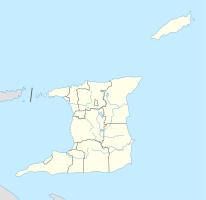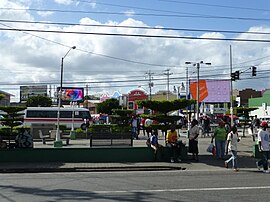San Juan (Trinidad and Tobago)
| San Juan | ||
|---|---|---|
|
Coordinates: 10 ° 39 ′ N , 61 ° 27 ′ W San Juan on the map of Trinidad and Tobago
|
||
| Basic data | ||
| Country | Trinidad and Tobago | |
| region | San Juan Laventille | |
| City foundation | 1790 | |
| Residents | 45,146 (2011) | |
| Detailed data | ||
| City structure | 7 communities | |
| Waters | San Juan River | |
| The San Juan bus station | ||
San Juan is a city in Trinidad and Tobago . It is located in the north of the island of Trinidad and is the administrative seat of the San Juan-Laventille region .
Location and structure
San Juan is located in the middle of the East-West Corridor , the metropolitan region of the state capital Port of Spain south of the Northern Range from west to east . Since Port of Spain is bounded in the north by the Northern Range and in the south by the Caroni Swamp , the city expanded to the east over time. The resulting East-West Corridor is so densely populated that in the past independent cities merge into one another and now have the character of districts of the capital agglomeration. However, they are still formally independent. San Juan is about 6 km east of the city limits of Port of Spain. It is bordered by Morvant to the west, Champs Fleurs to the east, Santa Cruz to the north and Barataria to the south . Politically, the city belongs to the constituency of Barataria / San Juan, and since the local elections in November 2016, Pernell Bruno (PNM) has been a member of the electoral district in the House of Representatives . San Juan is divided into the communities El Socorro, El Socorro Extension, San Juan, Aranguez, Petit Bourg, Febeau Village and Romain Lands. The San Juan River flows through the city in a north-south direction.
| Community | Residents |
|---|---|
| El Socorro | 8049 |
| El Socorro Extension | 2581 |
| San Juan | 15772 |
| Aranguez | 7404 |
| Petit Bourg | 5171 |
| Febeau Village | 5213 |
| Romain Lands | 916 |
| total | 45,146 |
history
At the end of the 17th century, Spanish Capuchin monks in the Aricagua region, named after the Arawak name for the San Juan River flowing there, founded a missionary church dedicated to St. John the Baptist was consecrated (Spanish: San Juan Bautista ). In 1790 under Spanish colonial rule by Governor José María Chacón , the settlement of San Juan was founded at this point in order to have a stopover about halfway between Puerto de España (Port of Spain) and the then capital San José de Oruña . The first settlers were French and came as part of the Cedula de populacion , an edict of the Spanish Minister José de Gálvez y Gallardo , which in 1783 allowed the increased settlement of French citizens on the Spanish island of Trinidad until 1797 and thus a significant increase in population and a rapidly increasing economic output the island made possible. The new citizens grew sugar cane and coffee. A census on the occasion of the British takeover in 1797 showed a population of 593 people for the Aricagua, of which 209 were white and free black. With the British, coffee cultivation was given up in favor of cocoa, and cotton and bananas were grown in San Juan to a small extent from then on. In 1828 the construction of a church began, which was dedicated to the patron saint of the city. After the administrative reforms initiated by Governor George Harris in 1849, San Juan received a police station and a primary school in 1851 and was (as one of the first cities in Trinidad) connected to the newly introduced postal network. In 1881 the population was 516. Surrounding plantations gradually grew into villages, which at some point merged with San Juan, so that the population of the city was already 6,500 in 1946 and rose to over 30,000 by 1970.
Economy and Transport
One of the city's largest employers is beverage bottler Joseph Charles Bottling Works and Investments Limited, which sells soft drinks and juices internationally under the Solo brand. The headquarters of Global Brands Limited, the largest fast-service restaurant company in the Caribbean, is located in San Juan. The Samba Brewing Company, one of two breweries in the country, is based in San Juan and sells its products in ten countries including the USA and Canada. A San Juan-based, Caribbean-based ice cream maker is Flavorite Ice Cream.
The Eastern Main Road, one of the main arteries of Trinidad, runs right through San Juan. From 1876 to 1968 San Juan was connected to the Trinidadian railway network; the last Trinidadian passenger train ran between San Juan and Port of Spain on December 28, 1968.
Facilities and culture
San Juan is the capital of the San Juan-Laventille region; the headquarters of the administrative authority of the San Juan-Laventille Regional Corporation is in the Aranguez district. There are three secondary schools and ten primary schools in San Juan, the latter partly run by religious organizations. The city has three Roman Catholic churches, two of the Seventh-day Adventists , a Hindu temple, a mosque, a Baptist church and one of the Evangelicals .
The Aranguez Savannah is a park-like open space, where a large Phagwah celebration and the Samaan Tree Rock Festival take place every year. Music styles endemic to Trinidad such as Soca , Calypso or Parang have a competitive character due to numerous competitions and therefore a high priority in the population. The steel band Pamberi Steel Orchestra and the Parang orchestra Alumnos de San Juan have their seats in San Juan. The four-time Trinidadian soccer champion San Juan Jabloteh is based in the city, but plays his home games at Hasely Crawford Stadium in Port of Spain due to the lack of a stadium .
Personalities
- Marvin Andrews (* 1975, footballer)
Individual evidence
- ↑ Census 2011
- ↑ NALIS.gov.tt: San Juan (de Aricagua). Retrieved March 19, 2016 .
- ↑ Michael Anthony: Towns and Villages of Trinidad and Tobago . 2nd Edition. Printmaster, Marabella 2001, p. 271 .
- ↑ Michael Anthony: Towns and Villages of Trinidad and Tobago . 2nd Edition. Printmaster, Marabella 2001, p. 274 .
- ↑ PTSC.co.tt: About Us: History ( Memento April 10, 2013 in the Internet Archive )
- ↑ Sheldon Cooper: Sheldon's Train Vacation Story . In: Trinidad Express . January 18, 2015.

